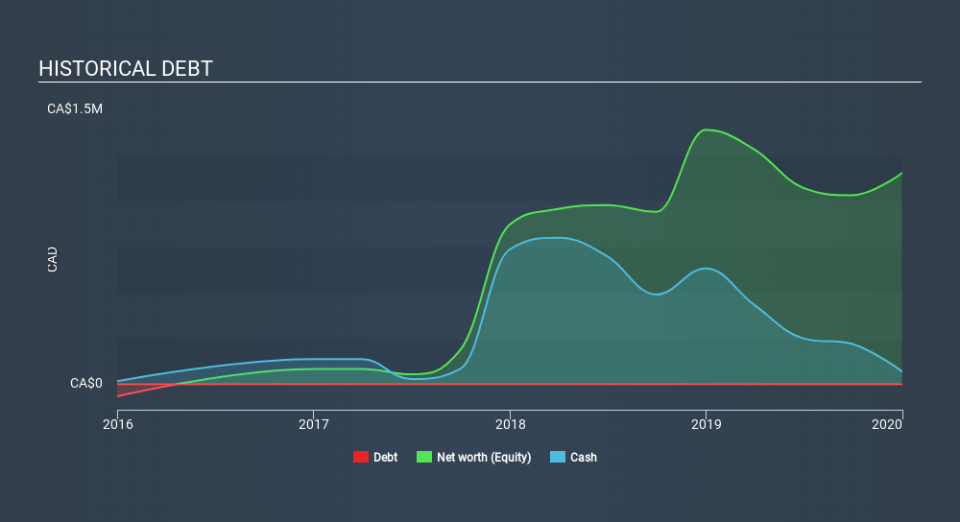Here's Why We Worry About Troubadour Resources's (CVE:TR) Cash Burn Situation

Even when a business is losing money, it's possible for shareholders to make money if they buy a good business at the right price. For example, although Amazon.com made losses for many years after listing, if you had bought and held the shares since 1999, you would have made a fortune. But while the successes are well known, investors should not ignore the very many unprofitable companies that simply burn through all their cash and collapse.
So, the natural question for Troubadour Resources (CVE:TR) shareholders is whether they should be concerned by its rate of cash burn. For the purpose of this article, we'll define cash burn as the amount of cash the company is spending each year to fund its growth (also called its negative free cash flow). First, we'll determine its cash runway by comparing its cash burn with its cash reserves.
Check out our latest analysis for Troubadour Resources
Does Troubadour Resources Have A Long Cash Runway?
A cash runway is defined as the length of time it would take a company to run out of money if it kept spending at its current rate of cash burn. In December 2019, Troubadour Resources had CA$70k in cash, and was debt-free. In the last year, its cash burn was CA$819k. So it seems to us it had a cash runway of less than two months from December 2019. To be frank we are alarmed by how short that cash runway is! The image below shows how its cash balance has been changing over the last few years.
How Is Troubadour Resources's Cash Burn Changing Over Time?
Troubadour Resources didn't record any revenue over the last year, indicating that it's an early stage company still developing its business. So while we can't look to sales to understand growth, we can look at how the cash burn is changing to understand how expenditure is trending over time. With the cash burn rate up 4.6% in the last year, it seems that the company is ratcheting up investment in the business over time. That's not necessarily a bad thing, but investors should be mindful of the fact that will shorten the cash runway. Admittedly, we're a bit cautious of Troubadour Resources due to its lack of significant operating revenues. We prefer most of the stocks on this list of stocks that analysts expect to grow.
How Hard Would It Be For Troubadour Resources To Raise More Cash For Growth?
Since its cash burn is increasing (albeit only slightly), Troubadour Resources shareholders should still be mindful of the possibility it will require more cash in the future. Issuing new shares, or taking on debt, are the most common ways for a listed company to raise more money for its business. Many companies end up issuing new shares to fund future growth. By looking at a company's cash burn relative to its market capitalisation, we gain insight on how much shareholders would be diluted if the company needed to raise enough cash to cover another year's cash burn.
Troubadour Resources's cash burn of CA$819k is about the same as its market capitalisation of CA$798k. That suggests the company may have some funding difficulties, and we'd be very wary of the stock.
How Risky Is Troubadour Resources's Cash Burn Situation?
As you can probably tell by now, we're rather concerned about Troubadour Resources's cash burn. In particular, we think its cash runway suggests it isn't in a good position to keep funding growth. While not as bad as its cash runway, its increasing cash burn is also a concern, and considering everything mentioned above, we're struggling to find much to be optimistic about. Its cash burn situation feels about as comfortable as sitting next to the lavatory on a long haul flight. It's likely to need more cash in the near term; and that could well hurt returns. On another note, Troubadour Resources has 6 warning signs (and 3 which are a bit unpleasant) we think you should know about.
Of course Troubadour Resources may not be the best stock to buy. So you may wish to see this free collection of companies boasting high return on equity, or this list of stocks that insiders are buying.
If you spot an error that warrants correction, please contact the editor at editorial-team@simplywallst.com. This article by Simply Wall St is general in nature. It does not constitute a recommendation to buy or sell any stock, and does not take account of your objectives, or your financial situation. Simply Wall St has no position in the stocks mentioned.
We aim to bring you long-term focused research analysis driven by fundamental data. Note that our analysis may not factor in the latest price-sensitive company announcements or qualitative material. Thank you for reading.

 Yahoo Finance
Yahoo Finance 
